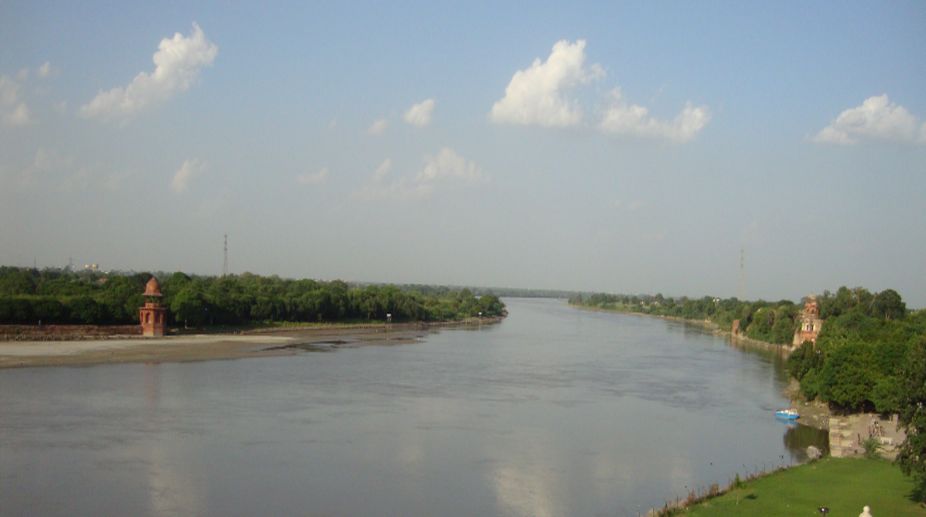Uma Bharti not to contest Lok Sabha polls
The BJP leader, however, clarified that she was not retiring from politics.

(Photo: Getty Images)
Adraft Ganga Act has reportedly been submitted to the Central Water Resources Ministry. Uma Bharati, Union Minister, has directed to constitute a high-level committee to go through the report and submit observations.
Government has also formed a committee to look into problems of depleting ground water and intends to introduce a model law to address the issue of rain water conservation. Incidentally, river and rains, both Nature’s gifts, are corelated as far as their management is concerned.
Rains, falling on lands, are drained into rivers running through the lengths of catchments and finally discharged into seas in natural drainage arrangements that keep the lands dry and habitable.
Advertisement
Out of total rain in catchments, a part is absorbed in land and the balance reaches the rivers, the quantum being dependent on a factor called “run off coefficient” that differs from catchment to catchment depending on their land characteristics, like soil, slope, shape, topography, surface vegetation and forest cover and in addition, on nature’s phenomena like temperature, wind and intensity of rain during rainfall.
People in the past coexisted with nature and planned their habitation without disturbing channel flows or flood plains of rivers. But presently, with availability of technology, growing population, demand for more lands and industrial needs, man is regulating nature’s rivers by putting dams, barrages and other obstructions randomly across them and encroaching also on their flood plains through construction of side embankments narrowing their widths.
In addition, as these traditional embankments are made of local earth, they become weak when wet and are easily breached to allow transport of denuded catchment surface soil into rivers by rain water run-offs causing their beds to rise and a reduction of flow capacities that affects their morphology.
Rivers thereafter inundate adjoining lands through these breaches in embankments and as floods recede, catchment rains are also wasted through the river into seas.
Loss of rain water, an annual gift of nature for sustenance of life on earth, is at the root of water woes to people and has to be stopped.
Also, control of rivers through dams/barrages in order to use them as water storages which act as supply heads to man-made irrigation/river link canals, gradually dries them up at their downstream ends, two glaring examples being the present condition of Damodar and Teesta rivers. Unfortunately, we lack the vision to understand that rivers form nature’s drainage system and if they are dried up, lands will not remain habitable for long.
So the preference of river and rain management steps should be to use river-friendly techniques so as to enable co-existence with nature.
Induction of breach-resistant side embankments in rivers is a technique that can prevent discharge of land rains and pollutants into them and along with it a ‘no obstruction across the river channels policy’ by law, will ensure protection to their geophysical characteristics. Furthermore, gates of all already existing dams/barrages need to be kept open round the year to sustain uninterrupted and pollution-free river flows.
The technique harnesses total catchment rains for surface storage and harvesting to augment water resources in the area. It is estimated that depending on rainfall intensity, approximately 3 to 5 per cent of catchment land of depth around 3 meters will suffice for storage of annual rain water in an area. In addition, proper sluices with gates can be provided in the embankments at suitable intervals to draw in excess river water or supplement land water to increase depleted river flows as necessary.
Apart from saving rain water, man’s only source of sweet water, from losses to enable its harvesting as well as protecting a channel’s geophysical characteristics for their survival, the other benefits accrued from induction of breach resistant embankments are (a) flood prevention to alleviate people’s distress and save public money wasted in flood relief; (b) maintaining purity of river flows to ensure source of good water supply to river valleys; (c) stoppage of entry and deposit of eroded land surface soil that affects stable drafts, necessary for inland water transport; (d) less erosion and bank protection as the rivers flow in their natural courses; (e) improved ground water quality with regard to its arsenic/fluride contents by recharging them with conserved rain water and (f) end of disputes amongst states over sharing of water of national rivers flowing through them.
This technique can also resolve controversies regarding exploitation of international river water between countries. Technology to reinforce traditional earthen embankments to make them breach resistant is, reportedly, available with Water Resources Section of Civil Engineering Department of IIT Kharagpur and was brought to the notice of West Bengal Government during a discussion to protect Sunderbans Islands after storm ‘Aila’ wiped out many kilometres of embankments from there in 2009.
The innovation is claimed to be fully rural employment oriented and executable under MGNREGA, having the potential to employ lakhs and lakhs of labourers all over the country to generate water assets.
Central and state governments may consider construction of these non breachable reinforced earthen embankments in pilot projects to test their efficacy and assess cost effectiveness to free India from floods and water scarcity including resolving related problems of health and agriculture.
The writer is an alumnus of the Indian Institute of Technology and works as a Consultant.
Advertisement